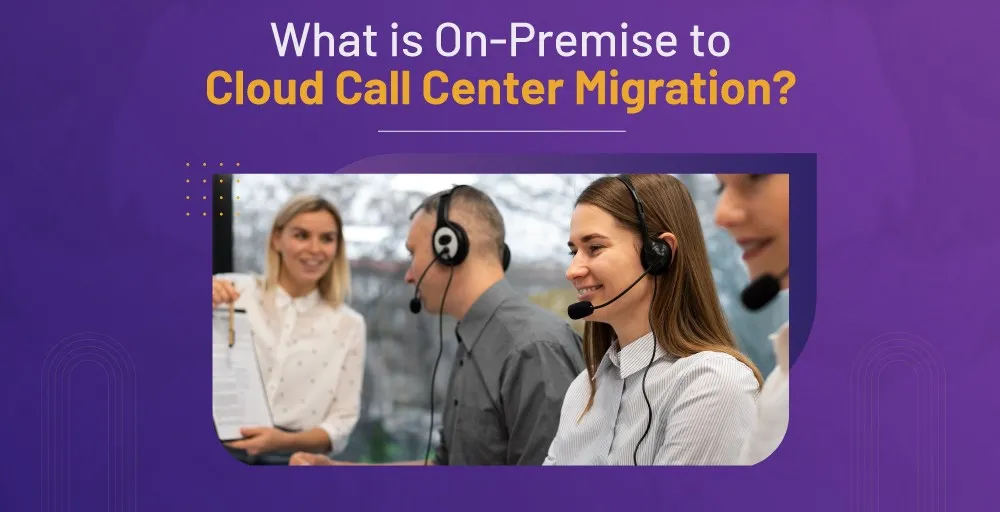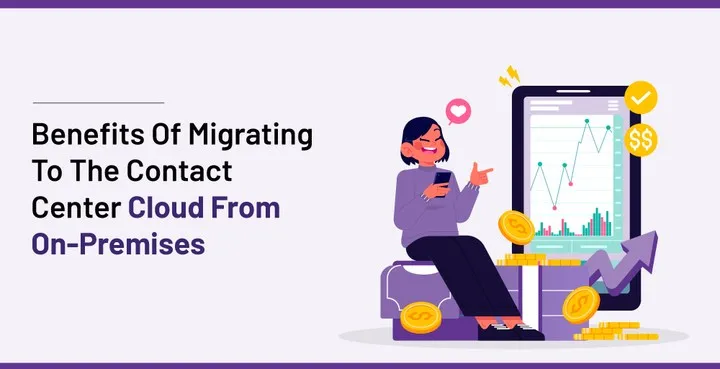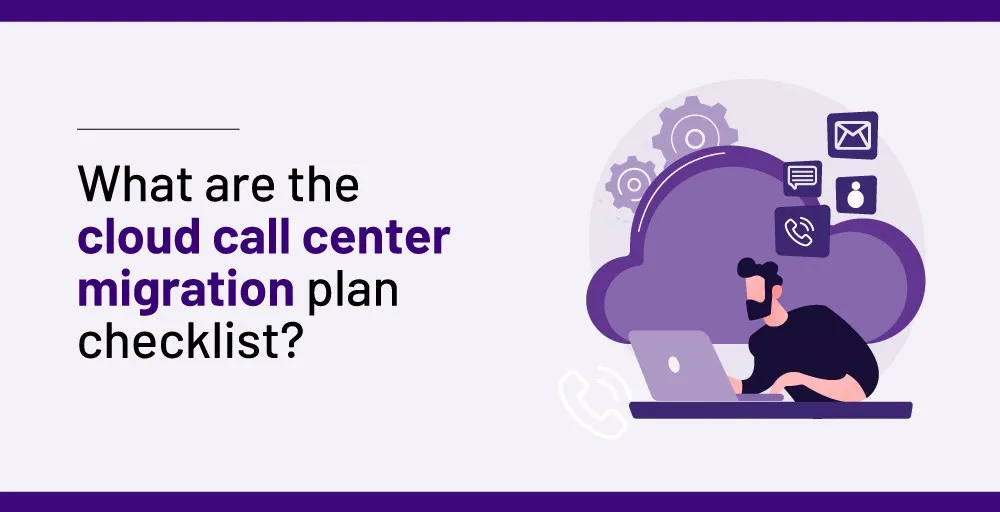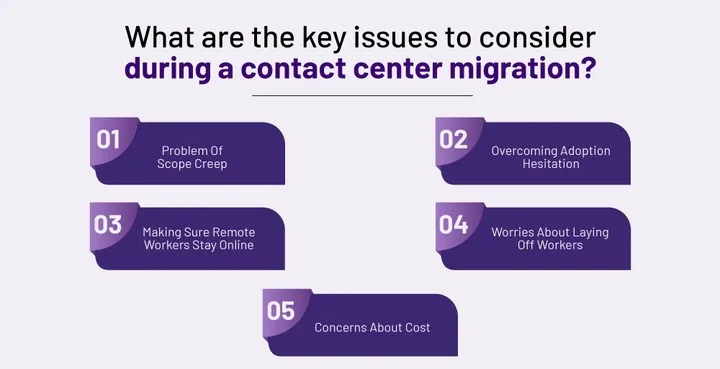Moving your call center from on-premise to the cloud offers many advantages, including enhanced scalability, flexibility, and cost-effectiveness. Cloud call center migration allows you to adapt to fluctuating call volumes, integrate seamlessly with other systems, and reduce infrastructure costs. 😊
The cloud call center also empowers your agents with tools for better customer interactions, such as real-time analytics and omnichannel support.
In this blog, we will discuss on-premise to cloud call center migration, its benefits, and its plan checklist. You will also understand how to choose the best cloud PBX solution for your business’s transition from on-premises systems and the key things to consider before your move. 🌟
Let’s begin. 👇
🔑 KEY HIGHLIGHTS
- On-premise to Cloud call center migration is the process of shifting all call center operations, including software, infrastructure, and data, from an on-site system to a cloud-based environment.
- Migrating contact center operations to a cloud-based environment improves customer service and engagement. Employees can use analytics tools to gain insights that help deliver more personalized customer service.
- Before migrating, assess current on-premise infrastructure like devices, systems, and software to understand what needs to be migrated and how.
- To choose the best cloud PBX solution, consider how well it integrates with other tools employees use, such as CRM systems.
- Choosing the right cloud provider is critical. Consider the best fit of capabilities, expertise, security, reliability, and customer service.
What is on-premise to cloud call center migration?
On-premise to cloud call center migration refers to the process of transitioning a call center’s operations, infrastructure, and software from an on-premise setup to a cloud-based environment.
In an on-premise setup, the call center infrastructure, including servers, software, and hardware, is located and managed within the organization’s premises. On the other hand, a cloud-based call center operates using software and services hosted on remote servers and accessed via the Internet.

However, moving a call center to the cloud isn’t just a simple update. It requires completely overhauling many parts of the call center operation. The process changes how customer service works, communication tools, and important systems operate.
Instead of relying on physical machines and networks located on-site, everything switches to virtual online resources managed remotely in the cloud. This involves transitioning all call center functions that handle customer interactions and the technology that powers calls, messaging, and other staff collaboration.
What are the benefits of migrating to the contact center cloud from on-premises?
Here are some of the benefits of moving data from on-premise systems to the contact center cloud:

1. Get rid of the hassle of working with different tech companies
Setting up, organizing, and fixing problems is more challenging when a company uses many separate programs and tech vendors. There is no simple way to ensure all the pieces work well together.
Cloud systems make it easier and cheaper to install, connect, and manage different communication tools together in one place. There’s less wasted time and money spent dealing with multiple tech companies that don’t sync up easily.
2. Adjust communication tools easily as the business expands or changes
Making an older phone system bigger to match company growth is a hassle. You must manually install new wires, routers, and switches everywhere, which takes time and costs money. Cloud systems use the regular internet instead of all those phone lines and equipment.
There’s no infrastructure of wires and devices to deal with constantly. The cloud can instantly boost calling, meetings, or messaging as needed. If the company shrinks or switches offices later, there’s no complicated network to rearrange. The cloud keeps communication options flexible and simple to increase alongside a changing business.
3. Stay competitive by quickly updating communication tools
Old phone systems can’t add new ways to connect like video calls or instant messaging within other programs people use daily. For example, sales teams work better when their customer relationship software links with the phone, so clicking names directly dials clients and automatically saves call details.
The cloud keeps communication options up-to-date and links them seamlessly into popular workplace apps. It lets businesses enable whatever features staff and customers want, now and later, through internet updates instead of slow hardware changes.
4. Get a better understanding of how communication works within your business
Old phone systems don’t provide much information about usage or give the big picture. Any details they share take a long time to gather and don’t show everything clearly, making the data useless most of the time.
Cloud communication tools give full visibility to calls, messages, meetings, and more. Clear, fast insights replace guesses with facts to guide decisions. By examining analytics in the cloud, they can understand problems and spot opportunities. Data-driven transparency replaces the dark with a clear direction for the business.
5. No stress about the system going down
Old phone networks don’t have good protection against problems. If the system crashes, it can cause issues for workers and customers. That could hurt your company’s reputation in the long run.
But cloud phone services are different. They have many backup servers in different locations. If one goes offline, others instantly take over, so no calls are dropped. Employees stay connected internally and externally no matter what.
On-Premise to Cloud Call Center Migration Checklist
Here is a simple checklist overview for organizing and carrying out migration securely:

1. Figure out what you need and want from the system
Before moving your call center to the cloud, you must know your goals and what must be included. Ask yourself questions like:
- How many locations and people will you move over?
- When do you want it done?
- What communication will agents need—just calls or texts, social media, etc.? If there are multiple types, you’ll want a system that connects them smoothly.
- How will you see stats and metrics in real-time to track how things are going?
- Do you need self-help options like a chatbot to answer some questions?
- What customer relationship program links are important? Can you build custom ties using their tools?
Knowing the answers will help you choose the right cloud call center partner and map out the project timeline so everything can be switched over smoothly.
2. Decide how you’ll know if the move is successful
Once you sign up with a new provider and choose features, determine how you’ll measure results. Try putting numbers to the goals. For example, do callers often wait a long time? If so, look for a system with good automated text response and call routing. Set a target of reducing hold times by 20%.
Think about other issues you’re facing now. Translate fixing them into quantifiable goals. Hitting those targets will show the cloud center upgrade truly worked well. Having clear expectations helps assess if the migration delivered what you wanted.
3. Sort out the logistics
Now, let’s examine the tactical details of moving platforms. Will all your core systems shift over? Do you have multiple offices? Will you transfer everything at once or in phases? Might you need help from the new provider?
Know how the change will unfold and what to do if issues pop up on launch day. A big thing to plan is downtime during the actual move. Since the call center can’t stop, choosing a provider who eases the transition smoothly is key. Have a solid process for any gaps or problems that may happen.
4. Set up firewalls
Firewalls in data centers protect networks, devices, and apps by allowing only approved people to access certain parts. Virtual private clouds (VPCs) offer powerful network and firewall options that don’t rely on location like normal office networks. VPCs give versatile security no matter where staff are working from.
5. Get your team ready through training
This is a crucial part – training people who will use the new system. The end-users (agents and their bosses) must learn the migrated platform. The cloud company should help teach through sessions or online platforms.
Making sure staff understands the changes fully prepares them. It helps the transition go smoothly instead of causing issues from confusion. The provider’s guidance gets your team up to speed on the new tools. Training makes or breaks how well call handling continues.
How do you choose the best cloud PBX solution for your business’s transition from on-premises systems?
There are many cloud options, and choosing which works best mostly depends on your business needs and money. Follow the steps below as they will help you choose the best cloud PBX solution for your business transition from on-premises systems:
- Make sure the cloud phone system you choose works well with the programs your workers use every day.
- It should connect nicely with tools like Salesforce, Hubspot, ServiceNow, and Zendesk.
- Look for solid controls and reports to catch issues and see how people use features regardless of where you are.
- It must offer great options for calling on computers, phones, and mobiles, whether users need basic or advanced features.
- Plus, it should do more than call, like sending texts, pictures, and faxes.
- Choose one with a history of staying up and running securely.
What are the best practices for on-premise call center migration to the cloud?
Moving to the cloud center cloud has many benefits. But despite all its perks, switching to contact center cloud services requires serious thought.
Some of the best practices for on-premise call center migration to the cloud are:
- Assessment and Planning: You can begin by assessing your current infrastructure, processes, and needs. Also, identify key stakeholders and create a detailed migration plan that outlines goals, timelines, budgets, and resources required for a successful transition.
- Select the Right Cloud Provider: Choose a reliable and reputable cloud contact center service provider that aligns with your business requirements. Consider factors such as scalability, security, compliance, uptime reliability, and support services offered by the provider.
- Data Migration Strategy: Develop a robust data migration strategy to ensure seamless transfer of customer data, call logs, configurations, and other critical information to the cloud platform. Use data encryption and backup procedures to safeguard sensitive information during migration.
- Integration with Existing Systems: You can plan to seamlessly integrate cloud-based call center solutions with your existing systems, such as CRM software, helpdesk tools, and communication channels. Ensure compatibility and smooth data flow between systems to maintain operational continuity.
- Training and Change Management: You can conduct comprehensive training programs for your staff to familiarize them with the new cloud-based call center tools and workflows. You can also implement change management strategies to ease the transition and address employees’ resistance or challenges.
- Scalability and Flexibility: Use the scalability and flexibility of cloud-based call center solutions to quickly adapt to changing business demands. Configure the system to accommodate fluctuations in call volume, add new features or services, and scale resources as needed without disruption.
- Security and Compliance: In the cloud environment, you can implement robust security measures such as data encryption, access controls, threat detection, and regular audits to protect customer data and ensure compliance with industry regulations (e.g., GDPR, PCI DSS).
- Performance Monitoring and Optimization: You can set up VoIP monitoring tools and performance metrics to track call center operations, identify bottlenecks or issues, and optimize system performance. You can also regularly review and fine-tune configurations to enhance efficiency and customer experience.
- Backup and Disaster Recovery: You can establish backup procedures and disaster recovery plans to mitigate risks of data loss, system downtime, or disruptions. Ensure backups are regularly updated and accessible to restore operations quickly in emergencies.
- Continuous Improvement: You may embrace a culture of constant improvement by gathering feedback from customers, agents, and stakeholders. Also, you can use analytics and insights from the cloud-based call center platform to make data-driven decisions, improve processes, and deliver exceptional customer service.
What are the key issues to consider during a contact center migration?
Even though call center cloud migration has many advantages, there are some things you need to consider before migrating from on-premise to the cloud, such as:

1. Problem of scope creep
When moving a call center to the cloud, the goals can change much without meaning. This is called “scope creep” and can cause big problems. If new things are added to the plan without checking how they affect time and resources, it could mean lots of extra time and money.
Call centers must clearly define the project and its goals to avoid scope creep. Communication between everyone involved, such as managers, tech staff, and vendors, is also essential. Any changes to the goals need to be carefully thought out and agreed on by everyone. This helps finish the project on time and budget without unexpected extras.
2. Overcoming adoption hesitation
Changing to a new cloud call center system can cause problems if employees don’t want to use it. This is called “adoption hesitation”. Workers may not like changes to technologies they aren’t used to or be worried about changes to their jobs.
Companies should choose easy-to-use cloud programs and create good training to deal with adoption hesitation. Staff need regular lessons and support to feel confident with the new system. Making the change less scary makes it easier. It also helps to let employees be part of planning the cloud move. If their questions and concerns are addressed, they feel more involved, which makes accepting the new system easier.
3. Making sure remote workers stay online
As more staff work from home, reliable internet is crucial for cloud call centers to run well. Weak internet can disrupt helping customers and reduce work done.
Companies must ensure remote employees have fast, dependable internet to fix this. That may mean helping with home workspaces or teaming with internet providers known for good service. It’s also key to consistently check connection quality and fast fixes when problems arise. This keeps customer care steady without interruptions.
4. Worries about laying off workers
Some companies don’t want to move to the cloud call center because they think it means firing workers. While on-site jobs maintaining old phone and computer systems will no longer be needed, switching to the cloud doesn’t automatically mean cutting jobs. In fact, brands can refocus employees on more important work, helping the business.
Also, cloud call centers improve staff work. Workers get frustrated when they can’t solve customer problems because information is spread across different systems. The cloud better integrates everything, allowing employees to find what they need to help callers easily.
5. Concerns about cost
Some companies with cloud-based call centers worry about money. Making the switch can cost a lot upfront, so companies must consider the right time for such a big change. For most, cloud call centers cost about the same as traditional ones. However, cloud systems offer many more benefits for the cash.
Also, many cloud providers let customers pay only for what they use, helping budgets go farther. Cloud call centers save more in general costs than regular ones because there’s less overhead and upkeep.
Ready to migrate your call center to the cloud?
Traditional on-premise call centers often face many challenges regarding cost, scalability, resource optimization, etc. However, migrating the call center operations to the cloud can address these issues. 💫
A cloud-based call center provides agents access to a virtual shared environment where all necessary applications and call center functionalities are centrally hosted. This allows for improved resource optimization compared to physical on-premise systems.
Call Center cloud migration also provides advanced features and tools that ensure scalability and cost efficiency. It enhances remote work capabilities as well as improves collaboration between different teams.
To migrate your call center, choose the right service provider to streamline your workflows and meet your business goals. KrispCall, a cloud-based call center software, can be a better option. It offers advanced call center features like call routing, call analytics, IVR, call forwarding, etc.
Thus, schedule a demo and try KrispCall today.
FAQs
What are the critical steps in migrating from on-premise to a cloud call center?
The critical steps in migrating from on-premise to a cloud call center consist of the following:
- Assessment and planning
- Choosing the right service provider
- Data migration planning
- Integration and compatibility
- Network and security setup
- Training and change management
- Phased implementation and testing
- Full-scale migration and deployment
- Ongoing optimization and support
What post-migration steps should businesses take to optimize their cloud call center operations?
Businesses should take these post-migration steps to optimize their cloud center operations:
- Performance monitoring and analysis
- Continuous training and development
- Customer feedback integration
- System updates and optimization
- Integration and compliance management
- Security and compliance management
- Disaster recovery planning





